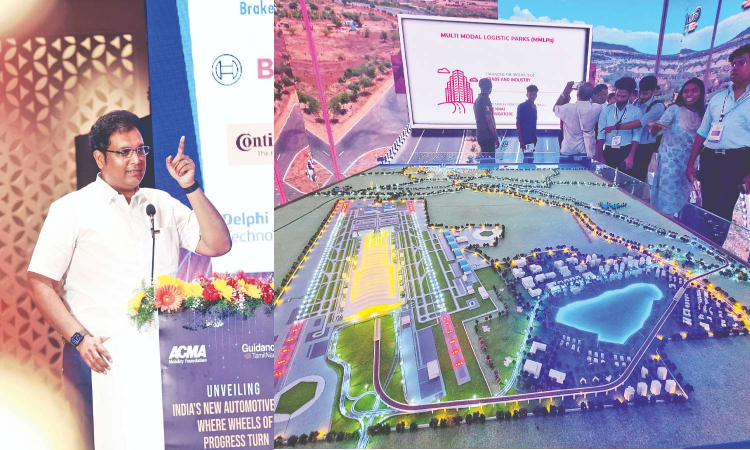Turning intent into action is TN govt's mantra to achieve $1 Trillion economy by 2030
With just five years remaining to reach the ambitious goal, Industries and Commerce Minister TRB Rajaa shares the roadmap to achieve inclusive development to DT Next

Minister for Industries TRB Rajaa; Model of the Parandur greenfield airport
CHENNAI: As Tamil Nadu sets its sights on becoming a trillion-dollar economy by 2030, the State is pushing an aggressive strategy focused on
job creation, industrial expansion, and inclusive growth across all districts. In an exclusive conversation with DT Next, the State Minister for Industries, Investment Promotion and Commerce, TRB Rajaa, outlines the government’s roadmap — from grounding MoUs and building global competitiveness to driving the next wave of semiconductor and electronics growth.
Excerpts from the interview follow
Q: TN has set an ambitious target to become a one-trillion-dollar economy by 2030. What are the immediate milestones you are focusing on to achieve this?
A: Our vision for Tamil Nadu at 2030 is ambitious, but it is built on clear, measurable steps. Our immediate focus is to sustain the momentum we’ve created — by adding 12–15 lakh new jobs every year, grounding all MoUs into tangible projects, and ensuring that every district participates in this growth story.
This government, under the leadership of Chief Minister MK Stalin, is deeply committed to turning intent into action. Since 2021, about 77 per cent of the MoUs signed have already progressed to various stages of implementation, land allotment, or production. That shows our approach is not just about announcements — it’s about delivery.
Q: One of the big-ticket infrastructure projects for Tamil Nadu is the Parandur Greenfield Airport. What is the current status, and how are you ensuring inclusive development?
A: The Parandur Greenfield Airport is progressing steadily. Land acquisition is under way, and we’re closely engaging with local communities to ensure that development remains inclusive and sensitive to their needs. This airport will serve as a critical infrastructure backbone for Tamil Nadu’s industrial ecosystem. It is expected to be completed within three years. Once completed, it will serve as a catalyst for export corridors such as Sriperumbudur and Oragadam, and beyond. The airport will not only boost connectivity but also drive new investments and employment opportunities in surrounding regions.
Q: The semiconductor sector has become a major area of focus globally. How is Tamil Nadu positioning itself in this emerging industry?
A: We see semiconductors as a strategic frontier for the next decade. Through our Semiconductor Mission 2030, Tamil Nadu is taking decisive steps to attract investment across the design, testing, and equipment manufacturing spectrum. Beyond incentives, we're investing in human capital. Under Naan Mudhalvan and our Schools of Semiconductor initiative, we’re partnering with premier institutions to train 4,500 engineers, with 2,000 in the first phase. This talent pipeline will be crucial in anchoring global players and building a robust local ecosystem. Our goal is clear — to make Tamil Nadu a leading hub for semiconductor innovation and manufacturing in South Asia.
Q: Tamil Nadu's electronics exports have seen impressive growth recently. How is the State planning to maintain its global competitiveness?
A: TN has already begun to compete on a global stage. Last year, our electronics exports crossed $14.6 billion, making us one of India’s leading exporters. We are also proud that a majority of iPhones made in India come from Tamil Nadu. We're no longer competing only with other Indian states. Our benchmarks are now Vietnam, Malaysia, and South Korea.
To stay ahead, we’re strengthening supply chains, enhancing port connectivity, and aligning skill development programs with industry requirements. By building an innovation-driven ecosystem, we aim to keep Tamil Nadu at the forefront of the global electronics landscape.
Q: The government often highlights 'distributed growth' as a cornerstone of its strategy. How is this being achieved on the ground?
A: Industrialisation in Tamil Nadu is not limited to a few urban pockets — that’s a deliberate policy choice. We’re committed to spatially balanced development. You can see this in projects like VinFast in Thoothukudi, Tata Power Solar in Tirunelveli, and Jabil in Tiruchy. Each of these investments is part of a broader effort to create industrial clusters, to improve regional infrastructure, and link our skilling ecosystem to local industry needs. This approach ensures that every district benefits from Tamil Nadu’s growth story- economically, socially, and environmentally.
Q: Looking ahead, how do you envision Tamil Nadu's industrial landscape by the end of this decade?
A: By 2030, we want Tamil Nadu to be a global benchmark for inclusive, innovation-driven, and future-ready industrialisation. With a strong foundation in manufacturing, technology, and human capital, coupled with our focus on sustainability and inclusion, I am confident Tamil Nadu will not only achieve its trillion-dollar vision but do so in a way that uplifts every segment of our society.



